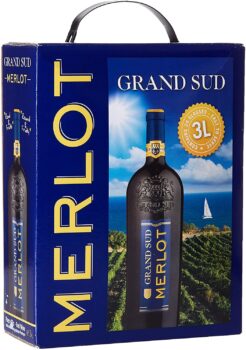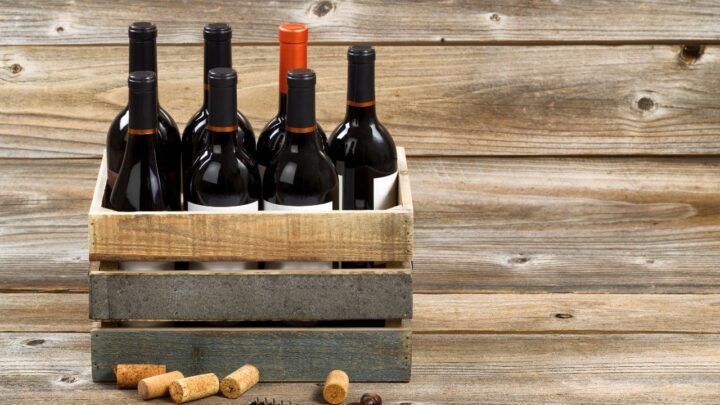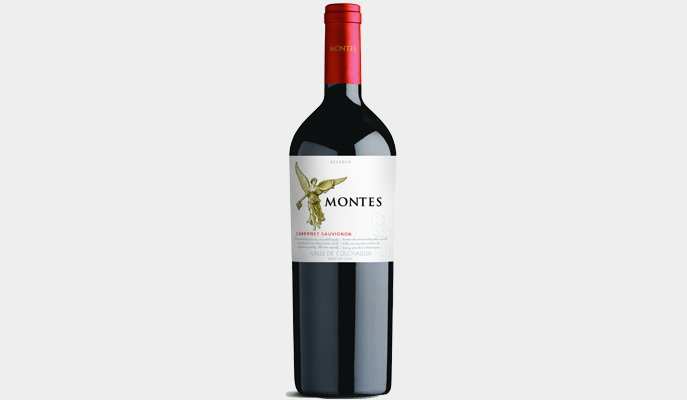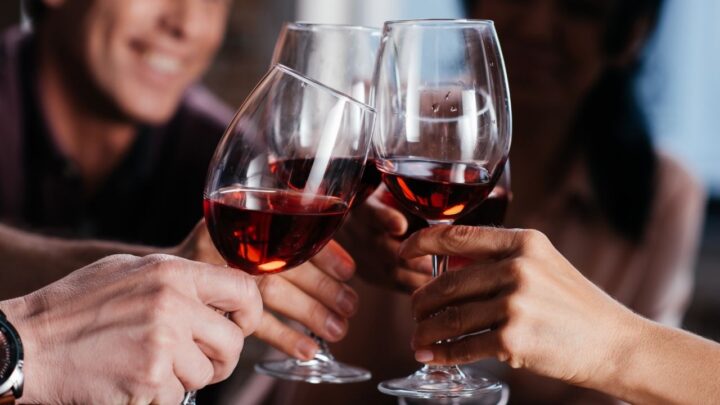When you dine in a restaurant, a sommelier will help you select the best red wine to go with the dish you order, taking into account your likes and dislikes. But how do you do that when you're shopping online with an almost infinite selection of red wines? The good news is that understanding some basic information about red wine will help you learn more about which bottles might be right for you. Or, don't waste time researching and discover through our guide the best red wines.
Here is our commitment, to make sure that we provide the best user experience and content quality:
You can support us by using our links to make your purchases (at no extra cost to you)! This sometimes earns us a commission which allows us to remain independent. More about us
Our selection
"Chateau Laffitte Laujac 2014 Medoc is an attractive vintage that started to show all its fruitiness in 2019. Today, this red wine has finally released…"
"The red wine Grand Sud Merlot du Pays d'Oc is made entirely from Merlot. We love its bright color, almost dark purple with ruby reflections.…"
"We can say without the slightest hesitation that Château Dauzac Margaux is a great way to make a first foray into the wines of Bordeaux…"
"The Grand Cru Bordeaux Marquis De Bellefont Saint-Emilion is an exceptional red wine. It stands out mainly by an explosion of flavors in the mouth…"

Chateau Laffitte Laujac 2014 Medoc is an attractive vintage that started to show all its fruitiness in 2019. Today, this red wine has finally released its full flavor. This is the best time to drink it.
27,89 £ on AmazonEqual proportions of Cabernet Sauvignon and Merlot give this wine a mature character. The aging of the wood shows in the smoky flavors that highlight the juicy black currant fruit. Medoc wines tend to be ruby colored, balanced and round on the palate with notes of cassis, cherry and earth, with firm tannins.
While most Bordeaux wines require aging, those labeled simply "Médoc" tend to be lighter and more accessible in their youth.. Grown on the gravel-rich soils of Bordeaux's left bank, Medoc wines are primarily blends of Cabernet Sauvignon and Merlot, but sometimes see the addition of Petit Verdot and Malbec. The result is a full-bodied red wine with high acidity.

The red wine Grand Sud Merlot du Pays d'Oc is made entirely from Merlot. We love its bright color, almost dark purple with ruby reflections. Its particularity remains its large capacity of 3 L.
11,36 £ on AmazonGrand Sud Merlot is a red wine produced in the Languedoc-Roussillon region of France, by Grand Sud. This 2018 vintage is from the Vin de Pays d'Oc appellation. It offers a complex and powerful nose, with aromas of red fruits, morello cherries and spiced with pepper. In the mouth, we retain flavors of red fruit, black currant, cherry and raspberry that remain long on the palate.
This is a full-bodied wine with 100% Merlot grapes ensuring a rather pronounced bitterness. The grapes used for this Grand Sud Merlot are harvested at perfect maturity. Grand Sud uses an advanced vinification at low temperature (between 15 and 18 °C).

We can say without the slightest hesitation that Château Dauzac Margaux is a great way to make a first foray into the wines of Bordeaux and its world-renowned Grands Crus.
43,92 £ on AmazonIn Château Dauzac Margaux, the alcohol is well integrated although the intensity of the Cabernet Sauvignon flavor remains relatively pronounced. This red wine has a real character which is expressed on three levels of aromas. First, you'll experience aromas of red cherry, blackberry, black plum and tomato leaf. Then come the notes of vanilla, chocolate and coffee.
As you leave the palate, you'll feel some hints of earth, tobacco and dried fruit. This 2017 vintage of Château Dauzac Margaux is perfectly suited for bottle aging. It has enough acidity, tannin and alcohol to probably hold up to 20 years of aging. It should be noted that Château Dauzac Margaux can perfectly accompany all classic meat dishes and Asian dishes.

The Grand Cru Bordeaux Marquis De Bellefont Saint-Emilion is an exceptional red wine. It stands out mainly by an explosion of flavors in the mouth with a harmonious and sensual combination.
17,74 £ on AmazonMade primarily from Merlot and Cabernet Franc, St. Emilion wines tend to have a rich, dry tannic structure on the palate, which is expertly balanced by the juicier characteristics of plum and black cherry, as well as chocolate and sweet spice, developing notes of tobacco and savory.
The best wines of St. Emilion, including this 2012 Grand Cru, will show a tremendous mineral streak, the result of planting vines on the region's limestone escarpment. Vines planted on sandy soils tend to produce grapes that yield lighter style wines, despite its full body and medium acidity.
Any specific needs?
Your guide :
Rate this buying guide :By rating this buying guide, you are helping us to reward our best writers. Thank you!
| TOP OF THE TOP | CHEAP | TOP OF THE LINE | EXCELLENT | |

In accordance with our commitment, this buying guide does not contain any sponsored products. |
 9/10 |
 7/10 |
 9/10 |
 8/10 |
| OUR SELECTION |
Château Laffitte Laujac 2014 Médoc
|
Grand Sud Merlot
|
Château Dauzac Margaux
|
Marquis De Bellefont Saint-Emilion Grand Cru
|
|
Chateau Laffitte Laujac 2014 Medoc is an attractive vintage that started to show all its fruitiness in 2019. Today, this red wine has finally released its full flavor. This is the best time to drink it.
|
The red wine Grand Sud Merlot du Pays d'Oc is made entirely from Merlot. We love its bright color, almost dark purple with ruby reflections. Its particularity remains its large capacity of 3 L.
|
We can say without the slightest hesitation that Château Dauzac Margaux is a great way to make a first foray into the wines of Bordeaux and its world-renowned Grands Crus.
|
The Grand Cru Bordeaux Marquis De Bellefont Saint-Emilion is an exceptional red wine. It stands out mainly by an explosion of flavors in the mouth with a harmonious and sensual combination.
|
|
|
Size
|
1.5 L
|
3 L
|
0.75 liter
|
0.75 L
|
|
Type
|
Corsé
|
Corsé
|
Mi-corsé
|
Corsé
|
|
Varietal(s)
|
Cabernet Sauvignon 60%, Merlot 35%, Petit Verdot 5%
|
Merlot 100%
|
Cabernet Sauvignon 100%
|
Merlot 90%, Cabernet Franc 10%
|
|
Millennium
|
2014
|
2018
|
2017
|
2012
|
|
Growing region
|
Bordeaux
|
Languedoc-Roussillon
|
Bordeaux
|
Bordeaux
|
Help us improve this table:
Report an error, request the addition of a feature to the table, or suggest another product. Thank you for your kindness!
We spend thousands of hours each year studying the major specialized websites, analyzing products of hundreds of brands and reading user feedback to advise you on the best products.
We are a product review company with a single mission: to simplify your buying decisions. Our research and testing helps millions of people every year find the best products for their personal needs and budget.
To support us you can: use our links to make your purchases (which often earns us a small commission), share our articles on social networks, or recommend our site on your blog. Thanks in advance for your support!

While the label on the bottle of red wine will always indicate the region and usually the variety(ies), preference plays an important role here. What other wines do you like? What regions do they come from? What varieties are they? As you develop your wine tasting experience, you begin to focus on the regions, varieties and combinations of these that interest you.
It also helps to know a little more about the different regions. Many lesser-known regions can offer huge amounts of value without the added costs associated with high land and grape prices. Probably the best advice we have about region when it comes to choosing a good bottle of red wine is that the smaller the better. While this is not a foolproof guarantee of quality, the more specific the region, the more likely it is to be a good vintage.
Reputation is important when choosing a good wine. Some producers are so reliable that you really can't go wrong with any of their wines. If you don't know anything about the winery, you can look at the back label of the bottle the back label and look for the sales designation (PDO, PGI), the provenance (wine of France, wine of the European Union, Product of France, etc.) and the name of the bottler, which is none other than the individual or corporation that does the bottling.
Generally, when a red wine is produced and bottled by the same company, it is a good sign indicating a high level of involvement of the winery in the cultivation and development of the red wine. On the other hand, there are a few caveats. Some large companies control thousands of acres of vineyards so they can label everything as "produced and bottled by." Some smaller wineries that make excellent wines can't, so they produce the wine, but outsource the bottling to a third-party company.
Do you choosea wine for yourself or do you share it with friends? Will you pair your wine with a meal or use it to prepare a recipe? Red wines in particular can serve different purposes and different occasions can influence how you choose your bottle. Here are some questions to ask yourself when buying a bottle of wine.
So if you want to please your friends or family and pairing with food is not your primary goal, opt for a red wine closer to the middle of the spectrum in sweetness and acidity. More balanced or moderate flavors are likely to appeal to the majority of your guests. If you want to find a wine to complement your carefully prepared dinner, red wines are best suited for heavier dishes, like beef and lamb.
Thepercentage of alcohol in a red wine can vary considerably for wines, but this is mainly related to the region, variety and style of the producer, so it is advisable to focus more on these criteria rather than the absolute number in your quest to choose a good bottle of red wine. However, a really high or low number that goes against what is expected for the style of wine could be an indicator that this particular wine may be made in a very different way than you expected.
Vintage refers to the year the grapes were harvested. On entry-level red wines, you shouldn't put too much emphasis on age. All the harvests in the last few years are fine for red wines. Chances are, if you're searching online using these tips on how to choose a good bottle of wine, it's for immediate consumption anyway. If you're looking for wines to cellar, you'll probably want to do more research before making your purchase.
Imported red wines should include the importer's name on the back label. Keeping track of importers of wines you like is a great way to find new wines that you might like, because the rest of their catalog will probably be of similar quality.
Red wine glasses will generally have a larger bowl than white wine glasses. This allows the bolder, fuller flavors of red wines to "breathe". By giving the wine enough room to absorb oxygen in the glass, the wine will open up and display its aromatic and taste qualities more easily. The rims of red wine glasses are wider for the same reason. Some red wine glasses may even have tulip-shaped rims to invite more air into the glass. There are basically three main categories of red wine glasses: red wine glasses, medium-bodied glasses and Burgundy glasses.

Light and refreshing, these are your "bridge reds," perfect for white wine drinkers looking to cross the bridge and join the Team Red. Light red wine can be drunk on its own, but also pairs well with food thanks to its lower bitterness. Some of the best light red wines include Pinot Noir, Beaujolais, Lambrusco and St. Laurent.

Thesewould be Goldilocks' favorite wines: neither too light nor too bold, they fall right in the middle. Medium-bodied reds have a bit more bitterness than lighter wines, but still don't hit you with complex structure or intense flavor. To find the best medium-bodied red wines, you'll want to look to Merlot, Cabernet Franc, Zinfandel, or Barbera.

Bodied reds have very high bitterness (and often the highest alcohol content), creating a heavy feel on the palate. Wines like these are best paired with rich, substantial foods, as they are bold enough to hold their own while still letting their flavors shine through. The best full-bodied red wines are Cabernet Sauvignon, Malbec, Shiraz and Petite Sirah.
One of the most popular wines, red wine gets its name from its rich, velvety dark color, ranging from purple to red to brown. It is made from dark colored grapes, the black and red types, and is processed with their skins. Red wines, normally aged in oak barrels, usually have a higher alcohol content. In this way, they lose their fruity tones and have instead sweet flavors and nutty notes. They pair well with lean meats, including stews and poultry. For snacks, it is perfect with cheese, pizza, salad and even chocolate.
White wine is made from white grapes, but there are also varieties made from darker grapes. It is light in color because the skins are removed before fermentation. Without the skins, white wine is sweeter than red wine. White wines are usually aged in stainless steel tanks that reduce oxidation, preserving their natural floral and fruity flavor. Refreshing and light, white wines are good before, between and after meals. They pair well with light dishes like fish, shrimp and vegetables. And because of its acidic, fruity taste and aroma, it is also ideal for cooking.
Choosing between white and red wine will depend on the season, the occasion and the type of food you are eating, not to mention your personal taste. Choosing a color is usually the starting point for selecting a specific wine. Some foods can straddle the line between white and red wine. Grilled salmon, for example, can be delicious with a rich white wine or a fruity red. But your personal preference for red or white wine will often be your first consideration in food and wine pairing. Food and wine pairings are one of the most fun aspects of wine, as the possible combinations are almost endless.

A long-term study published by the Harvard School of Public Health found that moderate drinkers with high blood pressure are 30% less likely to have a heart attack than their non-drinking counterparts.
In fact, red wine is good for your entire mouth. Red wine helps harden tooth enamel, which means fewer cavities. It also contains polyphenols, which help reduce gum inflammation and prevent gum disease (remember to brush your teeth well before bedtime).
Too many glasses of red wine won't do your vision any favors in the short term, but moderate consumption may help prevent cataracts in the long run, according to a 2003 study published in the journal Nature. The report found that moderate red wine drinkers were 32% less likely to develop cataracts than non-drinking participants, and 43% less likely than those who drank mostly beer.
Excessive alcohol consumption is often associated with diabetes, especially with sugary drinks. But a 2005 study from VU University in Amsterdam shows that moderate red wine drinkers are 30% less likely to develop type 2 diabetes than their non-drinking counterparts.
According to a Queen Mary University study, the bitterness in red wine provided by procyanidins helps protect against heart disease, while an antioxidant compound called resveratrol helps reduce saturated fats that build up in the arteries. Wines from Sardinia and southwestern France tend to contain more of these helpful ingredients.
In our opinion, the best brands of red wines in 2022 are :
Often considered one of the most exceptional wines in the world, Hermitage red wines are produced in the northern Rhône region with Syrah as the main grape variety. Particularly prized for their longevity, these powerful, full-bodied, complex, high-quality wines display bright aromas of red fruits, as well as spicy and floral nuances.
Theterroir of Bordeaux varies considerably from the right bank to the left bank. Thus, left bank wines are primarily Cabernet Sauvignon blended with some Merlot, and right bank wines are more Merlot or Cabernet Franc with a smaller amount of Cabernet Sauvignon. Some of the most famous Bordeaux wine brands include Chateau Laffitte and Chateau Haut Brion.
Burgundy is known for its fine wines like Chablis and Montrachet. Burgundy is also known for the wines of Beaune, Pouilly Fuissé and Côte de Nuits. Burgundy wines are classified as Grand Cru, Premier Cru, village appellation and regional appellation.
LeBeaujolais is a light red wine with relatively high amounts of acidity. It is made in the historic wine region of the Beaujolais province, primarily from the thin-skinned Gamay grape, which makes it very low in bitterness. It is classified into three categories: Beaujolais AOC, Beaujolais Villages AOC and Cru Beaujolais.
Createdin 1999, Grand Sud is an innovative, sun-drenched wine label. It markets varietal wines from the most picturesque and sunny vineyards in southern France.
The diagram below will help you to get an idea of the typical prices for each price range (entry-level, mid-range and high-end).
However, more expensive does not necessarily mean better.
We therefore advise you to always consult our ranking before deciding, rather than blindly relying on price ranges.
Look for "second label" wines
When wineries harvest grapes, their best, fully ripened grapes go into the first batch of wine, which they call their "first label." These wines are often the ones that connoisseurs praise and overwhelmingly have two qualities in common: they are often available in limited quantities and, therefore, can be very expensive. If you are just starting out and are not sure what wines you like, the price can be hard to justify. This is when second label wines can be a great alternative to expensive first label bottles.
Don't insist on the age of the wine
We'reused to saying the older the better. But when it comes to wine, that's not the case. Only some wines taste better with age, and different wines taste better after different periods of aging. How well wine ages depends on many factors, including the region of origin of the wine and the intensity of the bitterness, but also the sugar and acids in the wine.
Don't let price dictate your choice
Ifthe wine is on sale, it's probably because it's out of season or has been in the seller's inventory fora while.This doesn't mean the wine is inferior or won't still taste good if it's a type of wine you like. So when choosing the wine you want to buy, start with the flavors and characteristics you like best, as well as the occasion, and then let price be a secondary consideration.
Keep track of the wines you try
Onceyou've made your purchase, don't forget to note the name of the wine, the region, and the varietal. Many wine apps for your smartphone allow you to record your perception of a particular wine. As we said from the beginning, finding a "good wine" really depends on what you prefer, so tracking your likes and dislikes will help you choose better wines in the future.
Acidic foods need acidic wine
Ifyou choose a low-acid red wine to accompany a higher-acid meal, such as meals with citrus or fish, you're sure to be disappointed. The acidity of the food will overpower the red wine, leaving your taste buds wanting. In this case, it is best to find a more acidic red wine to accompany your meal.
Tannins are a compound found in wine that give red winean astringent and drying effect, and of course are bitter.
Terroir, from the French word terre, embodies various characteristics, such as climate, geology, and geography, and strives to describe how these elements intimately interact with each other, interact with the vine, and thus influence the wine.
Afterchoosing your red wine, you will need to remove the end of the cap that hides the cork. It is not necessary to remove the entire capsule. Take a knife and carefully slice the top, just above the ridge on the neck of the bottle. This allows you to remove the top of the capsule cleanly. The capsules on some of the older red wines may still be made of lead, but almost all modern capsules are made of less toxic materials (plastic, tin or aluminum foil).
Thenatural process of fermentation is to turn grape juice into an alcoholic beverage. Fermentation is an extremely important process in the making of wine, especially red wine. In fact, without it, wine cannot be produced. This is where a winemaker's expertise shines through. Although fermentation is a natural process, it can be manipulated, delayed, interrupted, accelerated in different ways. All this will surely be reflected in the final result. The temperature and speed of fermentation can be controlled by the winemaker for the best effect, and other factors such as oxygen levels in the must/juice are also carefully monitored and taken into account.
Every month we help more than 1 000 000 people buy better and smarter.
Copyright © 2022 - Made with ♥ by buyingbetter.co.uk
Your reviews and buying guides 0% advertising, 100% independent!